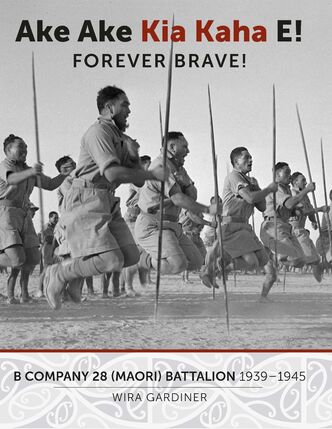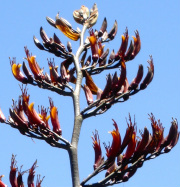
by Wira Gardiner
This is a monumental book in several ways. To begin with, its size quite sets it apart from any other war history this reviewer has read, for at 449 pages and weighing 2.2 kg, reading it on one’s knee is an invitation to an interrupted blood supply so that one is tempted to suggest that this coffee-table book might well replace the coffee table in its entirety.
However, and less facetiously, the book’s presentation is superb in every detail from beautifully-crafted endpapers through pages of sumptuous glossiness and a text superbly supported by images that, while containing their fair share of photographs that one would expect in a regimental history, more than occasionally go beyond that to throw up striking and timeless illustrations of what it means to be a Maori warrior. When that happens, the experience is akin to seeing a ray of sunlight pick out a salient feature of the landscape.
This begins on the page facing the Foreword with the totally arresting image of Hupa Hamiora pouring his spirit into the battalion’s tug-of-war team in leading a spontaneous haka; it continues through pictures of bayonet drill of understated lethality and Bren gunners who radiate a calm and practised precision in laying down fire, all the way to the picture of an un-named soldier in the Western Desert posing with a bayonet and a huge and toothless grin. To this reviewer, these images synthesise the way in which 28 (Maori) Battalion took men from backgrounds that were usually underprivileged, often educationally-deprived and more often than not economically challenged and overcame problems that ranged from fitting Maori feet into Pakeha-made boots to training ill-educated agricultural labourers for warfare in a technical age. All driven by the ‘way of the warrior’ that turned the Battalion into a fighting-force greatly admired by the legendary ‘Desert Fox’, Erwin Rommel, himself one of the 20thcentury’s greatest warriors.
The book owes much to JF Cody’s official history of the parent organisation, 28 (Maori) Battalion, but that is inevitable. Where it is different is in its presentation to the niche market of the heartland of Te Arawa and Mataatua, and it offers an account of these men’s war that is comprehensive to the point, sometimes, of detracting from the narrative flow in order to detail who did what, with whom and when. Again, however, the book’s positioning for a specific market almost guarantees this, and anyone seeking the ‘broad sweep’ still has Cody’s excellent history available.
Gardiner’s decision to background ‘B’ Company’s war story in the social and economic milieu of its participants is an outstanding part of the book, as is his treatment of 28 Battalion’s efforts to keep alive the manaof the ‘greatest tauain history’ in post-war years. He neither shirks nor sweeps under the rug the less pleasant aspects of the Company’s story: the PTSD, the treatment, even from their own comrades, of PoWs, problems of rehabilitation and the differentiated social and economic treatment accorded returned men.
What might have been done better? The short answer is: very little. However, the work might have been enhanced by more searching content-editing. There are a number of non-sequitursthroughout, as well as places where one story is interrupted by another; and two examples occur in Chapter 4 ‘Greece’, where the narrative is interrupted by a sizeable account of what captured officers did in captivity within Germany, and again in Chapter 6 ‘The Home Front’ which is much more concerned with troop movements than its advertised content. Large-scale maps that feature restricted areas are also an irritant especially in the seminal battles of Crete and the Western Desert because these are where the weapon that was ‘B’ Company and its parent was forged.
However the critical eye is less important to this wonderful book than the size of the lump in the throat when reading of the carnage of Takrouna among ‘B’ Company’s officers and NCOs, or the devastation wrought by the Gazala battle among whole home communities in ‘B ‘Company’s recruiting area, or the fact that the battle for the Cassino railway station took 74% of the Company’s strength and left it but one officer. Neither is the size of that lump diminished by the unrewarded exploits of the Manahis and the Horopaperas, nor the suffering of the Wikiriwhis. In the context of the understated bravery that is really understated heroism, it is fitting that Gardiner and his fine team not only include a Roll of Honour for the fallen but a photograph of every man of ‘B’ Company that they could find.
In all ways and all things, these men and their comrades more than lived up to the accolade bestowed on their Queenite forebears of the Arawa Constabulary almost a century before: Te Arawa piri pono. ‘The Arawa: loyal and true.’
Author: Wira Gardiner
Publisher: Bateman Books
ISBN: 978 -1-86953-985-6
RRP: $49.99
Available: bookshops

 RSS Feed
RSS Feed
